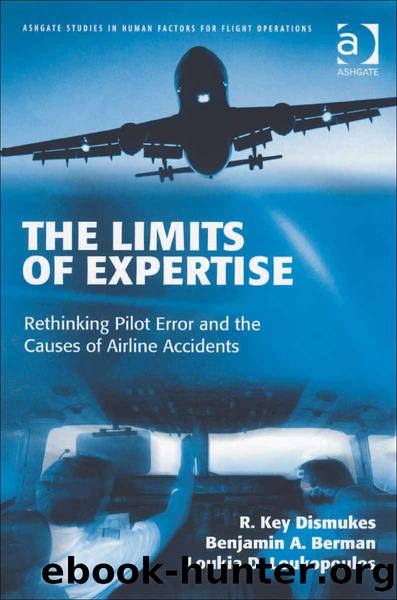The Limits of Expertise (Ashgate Studies in Human Factors for Flight Operations) by R. Key Dismukes & Benjamin A. Berman & Loukia D

Author:R. Key Dismukes & Benjamin A. Berman & Loukia D. [Dismukes, R. Key]
Language: eng
Format: mobi
Publisher: Ashgate Publishing
Published: 2012-09-30T16:00:00+00:00
4. The airplane stalled, was unable to climb, and departed from controlled flight in a left roll
Slightly less than five seconds after rotation began, the stall warning stickshaker activated. The first officer recalled that at this time the airframe was buffeting, the airplane could not climb out of ground effect, and it rolled to the left despite the control inputs of the two pilots.
The flight simulation studies conducted as part of the investigation revealed that by this time an accident was inevitable. The early rotation had caused the angle of attack to exceed the normal post-takeoff value of 9 degrees, and wing contamination had reduced the stalling angle of attack from the normal value of 12 degrees to approximately 9 degrees. The airplane entered an aerodynamic stall, and drag from the stall prevented the airplane from climbing or even accelerating in level flight. There was insufficient runway on which to land and stop, and there was no altitude to give up in order to gain airspeed. The post-stall controllability of the airplane was poor, with a roll-off that was probably aggravated by unequal stalling of the two wings from uneven wing contamination.
The stall warning system did not alert the crew until the airplane was already in a stalled condition because the wing contamination caused the wing to stall at a lower than normal angle of attack. Aircraft certification standards require that transport airplanes provide crews with adequate warning prior to the actual stall; however, as the circumstances of this accident show (see also Chapter 5), the certification standards do not appear to provide for adequate stall detection in the event of wing contamination. If the stall warning system had activated before flight 405 entered a full stall, the crew conceivably could have reacted quickly enough to lower the nose and accelerate in ground effect to an adequate speed. However, even with this warning, the time available to respond was so short and the angle of attack was so close to the critical angle at the moment of rotation that it is not at all clear that the crew could have recovered.
It is also conceivable that some pilots in this situation might have recognized the signs of imminent stalling before the stall warning activated, through airframe buffeting; however, this is improbable. Very little time was available to interpret the unexpected and ambiguous indications of airframe buffeting. Also, air carrier pilots receive substantial training and simulator practice that causes imminent stall to be strongly associated in memory with stickshaker activation. This association might further delay recognition of airframe buffeting as a sign of imminent stalling in the absence of stickshaker activation.
Download
This site does not store any files on its server. We only index and link to content provided by other sites. Please contact the content providers to delete copyright contents if any and email us, we'll remove relevant links or contents immediately.
| Automotive | Engineering |
| Transportation |
Whiskies Galore by Ian Buxton(41716)
Introduction to Aircraft Design (Cambridge Aerospace Series) by John P. Fielding(33014)
Small Unmanned Fixed-wing Aircraft Design by Andrew J. Keane Andras Sobester James P. Scanlan & András Sóbester & James P. Scanlan(32683)
Craft Beer for the Homebrewer by Michael Agnew(18079)
Turbulence by E. J. Noyes(7891)
The Complete Stick Figure Physics Tutorials by Allen Sarah(7262)
Kaplan MCAT General Chemistry Review by Kaplan(6819)
The Thirst by Nesbo Jo(6752)
Bad Blood by John Carreyrou(6472)
Modelling of Convective Heat and Mass Transfer in Rotating Flows by Igor V. Shevchuk(6352)
Learning SQL by Alan Beaulieu(6158)
Weapons of Math Destruction by Cathy O'Neil(6080)
Man-made Catastrophes and Risk Information Concealment by Dmitry Chernov & Didier Sornette(5874)
Digital Minimalism by Cal Newport;(5582)
Life 3.0: Being Human in the Age of Artificial Intelligence by Tegmark Max(5402)
iGen by Jean M. Twenge(5320)
Secrets of Antigravity Propulsion: Tesla, UFOs, and Classified Aerospace Technology by Ph.D. Paul A. Laviolette(5236)
Design of Trajectory Optimization Approach for Space Maneuver Vehicle Skip Entry Problems by Runqi Chai & Al Savvaris & Antonios Tsourdos & Senchun Chai(4955)
Electronic Devices & Circuits by Jacob Millman & Christos C. Halkias(4862)
